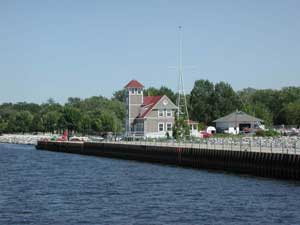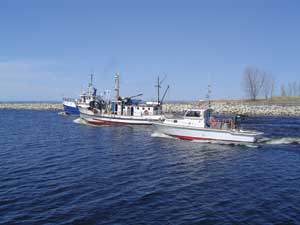Treading Lightly on the Great Lakes




May 25, 2007
BY Nicholas Zeman
The diversity of mammals, amphibians, reptiles, birds and fish that exist in the Great Lakes basin make for a complicated ecosystem. To the north, the famous dense hardwood forests sustain a solid wood and paper industry. To the south, marshes and wetlands provide a striking contrast and support a vast catalog of wildlife. As the largest surface area of fresh water in the world, the Great Lakes are a veritable cornucopia of resources, in addition to providing 56 billion gallons of water per day for municipal, agricultural and industrial use.
The industrialization of the Great Lakes region began in the early 20th century, resulting in many harmful environmental impacts. In fact, part of Lake Erie is dead. Today, however, many of the practices that proved to be destructive are being curtailed, and new practices focused on cleanliness, health and preservation are gaining momentum. That's where biodiesel fits in.
The National Atmospheric and Oceanic Administration (NOAA) operates a fleet of research vessels and small boats, and has replaced petroleum usage with biodiesel and biodegradable hydraulic oils, transmission fluid, maintenance lubricants and cleaners. The NOAA is a federal agency responsible for ecosystem management, weather forecasting, data collection, and sustainable practices for commerce and transportation. It's pioneering the use of biodiesel in marine applications as part of its identity and mission.
The NOAA's Great Lakes Environmental Research Laboratory (GLERL), with facilities in Muskegon and Ann Arbor, Mich., set out to operate completely petroleum-free vessels as the main objective of its "Green Ship Initiative." The ships used in the initiative are the first in the federal fleet to run on B100. "We're 100 percent biobased," says Dennis Donahue of GLERL. "We initiated the fleet to biodiesel incrementally by ship. Under our laboratory, there are about 40 vessels involved in the Green Ship Initiative."
One of the focuses of the GLERL's research has been the use of biofuels in marine applications. Donahue and company have gained valuable experience with all of the handling and logistical issues involving biodiesel, such as cold flow, storage stability and market availability. "There's been a dramatic increase in product from when we first started," Donahue says. "B100 in Michigan is about as prolific as No. 2 diesel, which means next-day delivery is available throughout most of the state." According to the GLERL, this can be attributed to the increased distribution network created by the increased demand for B20 and the growth in production capacity, which has also contributed to cost reductions. Currently, the GLERL procures its biodiesel from Crystal Flash Co. of Grand Rapids, Mich.
Sea Sickness Cure
As a division of NOAA, GLERL is committed to studying and subsequently addressing some of the environmental problems that have plagued the Great Lakes, including invasive species, erosion, nitrogen runoff and transportation pollutants. Over the past seven years, the Green Ship Initiative has built strong field experience with biodiesel "over a broad spectrum of engine, equipment and vessel designs," Donahue says.
Field tests documenting emissions in regard to the use of B100 aren't currently available. However, Donahue doesn't need a scientific study to find out how his colleagues feel about biodiesel emissions. The crew and passengers on deck, who are often directly in the exhaust plume, have become big fans of the renewable fuel. The use of biobased products has improved the work environment of the ships' crew and the scientists who are subjected to long-term exposure of diesel emissions. "There's been a dramatic reduction in sea sickness," Donahue says. "With biodiesel, there aren't those strong fumes that have people going over the side."
GLERL's stance is that when compared with high-sulfur petroleum diesel, the substantial reductions in particulate matter (47 percent) and hydrocarbons (68 percent) make a strong argument for using B100. Even though the U.S. EPA standards are becoming more stringent for new boat engines, those already in operation have been grandfathered in. This means that because of the long life span of diesel motors, a substantial percentage of vessels will continue to operate at emissions levels above the newest standards for many years to come. B100 may be a solution to lower the emissions of those engines in the legacy fleet, which are exempt from the latest EPA standards that went into effect in 2004, Donahue says. Biodiesel hasn't seen a lot of penetration in the marine environment, but these new regulations for both marine fuels and engines could create significant opportunities for methyl esters in this sector. The groundbreaking work that the NOAA and the GLERL have performed should make all private boat owners and commercial fleet operators confident that B100 can match the performance of traditional petroleum-based marine fuels.
100 Percent Biobased
Renewable Lubricants Inc., (RLI) in Hartville, Ohio, has been supplying the green ships with hydraulic lube, transmission fluid and other renewable mechanical liquids to keep the ships running smoothly. Using biodegradable vegetable oils in onboard systems like crank cases, gear boxes and hydraulics, offers an additional level of environmental protection in the event of spills or other accidental leaks. "They developed motor oil specifically for the diesel engines that we were involved in testing," Donahue says. "They also have a logistical and technical support program that has been very important to us."
RLI, which makes mechanical fluids from soy, canola, sunflower and corn oils, takes steps in its laboratories during the design process to make sure that the process of converting road vehicles or ships to a renewable platform is simple, says RLI Vice President William Garmier. "We focus on compatibility," he says. "We want our customers to make the changeover without doing a major flush. We don't have them go through any major work."
Because the companies interested in using biodiesel are likely to embrace other renewable products, the marine industry has quickly become a hot market. "Cities and other areas around water have been very proactive in looking for alternatives [to petroleum]," Garmier says. "Marine markets are becoming very good for us."
All of these products have undergone rigorous testing and are equivalent in performance to their petroleum counterparts, Donahue says. "These are no-fault, no-fail systems," Garmier says. "If those NOAA weather ships are out at sea, they can't afford to have a failure if a storm is coming and they need to get back to port … they're dealing with some rough territory."
B100 along with nonpetroleum-based fluids and lubricants has performed at the same level or better than traditional products. Significantly, the detergent effect of biodiesel has led to less downtime needed for manual cleaning, Donahue says. Anticipating this fuel characteristic, the GLERL installed duplex filters in its ships prior to converting to a biobased operating platform. When the ships burned the first two tanks of B100, the fuel filters required replacement at nearly three times the pace of normal fuel filter changes. "This is because the biodiesel was washing the gum and gunk out of the system," Donahue says. Overall, biodiesel's qualities as a solvent have contributed to improved fuel system maintenance, which leads to better engine performance. The use of exclusively renewable lubricants and fluids has kept the ships running at peak performance, while simultaneously providing an added measure of environmental protection against leaks and spills. "The old idea that vegetable oils won't work in high-performance applications-we've proved that wrong," Garmier says.
Nicholas Zeman is a Biodiesel Magazine staff writer. Reach him at nzeman@bbibiofuels.com, or (701) 746-8385.
The industrialization of the Great Lakes region began in the early 20th century, resulting in many harmful environmental impacts. In fact, part of Lake Erie is dead. Today, however, many of the practices that proved to be destructive are being curtailed, and new practices focused on cleanliness, health and preservation are gaining momentum. That's where biodiesel fits in.
The National Atmospheric and Oceanic Administration (NOAA) operates a fleet of research vessels and small boats, and has replaced petroleum usage with biodiesel and biodegradable hydraulic oils, transmission fluid, maintenance lubricants and cleaners. The NOAA is a federal agency responsible for ecosystem management, weather forecasting, data collection, and sustainable practices for commerce and transportation. It's pioneering the use of biodiesel in marine applications as part of its identity and mission.
The NOAA's Great Lakes Environmental Research Laboratory (GLERL), with facilities in Muskegon and Ann Arbor, Mich., set out to operate completely petroleum-free vessels as the main objective of its "Green Ship Initiative." The ships used in the initiative are the first in the federal fleet to run on B100. "We're 100 percent biobased," says Dennis Donahue of GLERL. "We initiated the fleet to biodiesel incrementally by ship. Under our laboratory, there are about 40 vessels involved in the Green Ship Initiative."
One of the focuses of the GLERL's research has been the use of biofuels in marine applications. Donahue and company have gained valuable experience with all of the handling and logistical issues involving biodiesel, such as cold flow, storage stability and market availability. "There's been a dramatic increase in product from when we first started," Donahue says. "B100 in Michigan is about as prolific as No. 2 diesel, which means next-day delivery is available throughout most of the state." According to the GLERL, this can be attributed to the increased distribution network created by the increased demand for B20 and the growth in production capacity, which has also contributed to cost reductions. Currently, the GLERL procures its biodiesel from Crystal Flash Co. of Grand Rapids, Mich.
Sea Sickness Cure
As a division of NOAA, GLERL is committed to studying and subsequently addressing some of the environmental problems that have plagued the Great Lakes, including invasive species, erosion, nitrogen runoff and transportation pollutants. Over the past seven years, the Green Ship Initiative has built strong field experience with biodiesel "over a broad spectrum of engine, equipment and vessel designs," Donahue says.
Field tests documenting emissions in regard to the use of B100 aren't currently available. However, Donahue doesn't need a scientific study to find out how his colleagues feel about biodiesel emissions. The crew and passengers on deck, who are often directly in the exhaust plume, have become big fans of the renewable fuel. The use of biobased products has improved the work environment of the ships' crew and the scientists who are subjected to long-term exposure of diesel emissions. "There's been a dramatic reduction in sea sickness," Donahue says. "With biodiesel, there aren't those strong fumes that have people going over the side."
GLERL's stance is that when compared with high-sulfur petroleum diesel, the substantial reductions in particulate matter (47 percent) and hydrocarbons (68 percent) make a strong argument for using B100. Even though the U.S. EPA standards are becoming more stringent for new boat engines, those already in operation have been grandfathered in. This means that because of the long life span of diesel motors, a substantial percentage of vessels will continue to operate at emissions levels above the newest standards for many years to come. B100 may be a solution to lower the emissions of those engines in the legacy fleet, which are exempt from the latest EPA standards that went into effect in 2004, Donahue says. Biodiesel hasn't seen a lot of penetration in the marine environment, but these new regulations for both marine fuels and engines could create significant opportunities for methyl esters in this sector. The groundbreaking work that the NOAA and the GLERL have performed should make all private boat owners and commercial fleet operators confident that B100 can match the performance of traditional petroleum-based marine fuels.
100 Percent Biobased
Renewable Lubricants Inc., (RLI) in Hartville, Ohio, has been supplying the green ships with hydraulic lube, transmission fluid and other renewable mechanical liquids to keep the ships running smoothly. Using biodegradable vegetable oils in onboard systems like crank cases, gear boxes and hydraulics, offers an additional level of environmental protection in the event of spills or other accidental leaks. "They developed motor oil specifically for the diesel engines that we were involved in testing," Donahue says. "They also have a logistical and technical support program that has been very important to us."
RLI, which makes mechanical fluids from soy, canola, sunflower and corn oils, takes steps in its laboratories during the design process to make sure that the process of converting road vehicles or ships to a renewable platform is simple, says RLI Vice President William Garmier. "We focus on compatibility," he says. "We want our customers to make the changeover without doing a major flush. We don't have them go through any major work."
Because the companies interested in using biodiesel are likely to embrace other renewable products, the marine industry has quickly become a hot market. "Cities and other areas around water have been very proactive in looking for alternatives [to petroleum]," Garmier says. "Marine markets are becoming very good for us."
All of these products have undergone rigorous testing and are equivalent in performance to their petroleum counterparts, Donahue says. "These are no-fault, no-fail systems," Garmier says. "If those NOAA weather ships are out at sea, they can't afford to have a failure if a storm is coming and they need to get back to port … they're dealing with some rough territory."
B100 along with nonpetroleum-based fluids and lubricants has performed at the same level or better than traditional products. Significantly, the detergent effect of biodiesel has led to less downtime needed for manual cleaning, Donahue says. Anticipating this fuel characteristic, the GLERL installed duplex filters in its ships prior to converting to a biobased operating platform. When the ships burned the first two tanks of B100, the fuel filters required replacement at nearly three times the pace of normal fuel filter changes. "This is because the biodiesel was washing the gum and gunk out of the system," Donahue says. Overall, biodiesel's qualities as a solvent have contributed to improved fuel system maintenance, which leads to better engine performance. The use of exclusively renewable lubricants and fluids has kept the ships running at peak performance, while simultaneously providing an added measure of environmental protection against leaks and spills. "The old idea that vegetable oils won't work in high-performance applications-we've proved that wrong," Garmier says.
Nicholas Zeman is a Biodiesel Magazine staff writer. Reach him at nzeman@bbibiofuels.com, or (701) 746-8385.
Advertisement
Advertisement
Upcoming Events





